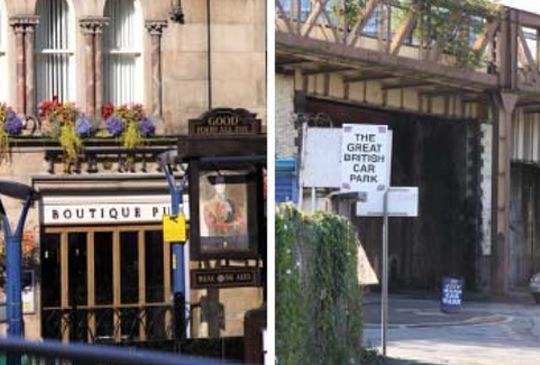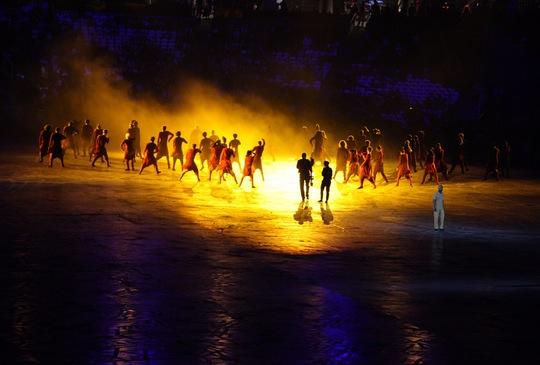
Perspectives essay: Urban faultlines and the dissonant city
There are different ways of looking at the city. As an archaeologist, I privilege the materiality of the urban environment, the palimpsests through which the traces of earlier structures and ways of living are evident and the contradictions – faultlines – that give all contemporary cities their creativity, vibrancy, uncertainty and senses of danger.
This view of the city is one of perpetual dissonance, captured in Tim Edensor's foregrounding of ruins: "as disordered and messy sites, ruins provide a contrast to the increasingly smooth, highly regulated spaces of the city. Occurring in the back roads and interstices of the urban fabric, ruins deride ideals which champion the virtues of seamlessness" (Edensor 2005: 53). Faultlines in the city show the tension between hygiene - ranging from waste management to narrative heritage - and transgression, whether the insistence is on different readings of heritage, rebellion, or riot.
This context of urban faultlines is well expressed in Friedrich Engels' first impressions of Manchester in December 1842 when he arrived, aged 22, as an understudy at the Salford mill owned by his father. "The town itself", he wrote, "is peculiarly built, so that a person may live in it for years, and go in and out daily without coming into contact with a working-people's quarter or even with workers, that is, so long as he confines himself to his business or to pleasure walks". Engels attributed this to the combination of "unconscious tacit agreement" and "outspoken conscious determination" to keep separate the parts of the city intended for middle class use, from the areas reserved for working class housing.
The nadir is the river, "a narrow, coal-black, foul-smelling stream, full of debris and refuse", "a long string of the most disgusting, blackish-green, slime pools ... from the depths of which bubbles of miasmatic gas constantly arise and give forth a stench unendurable even on the bridge forty or fifty feet above the surface of the stream."
This faultline is clear in Engels' account of his walk from the Cathedral and Long Millgate – older houses "whose former inhabitants have removed with their descendants into better built districts" – and down into the courts and lanes: "irregular cramming together of dwellings in ways which defy all rational plan"; where "even the shops and beer houses hardly take the trouble to exhibit a trifling degree of cleanliness"; "filth and disgusting grime"; "a privy without a door, so dirty that the inhabitants can pass into and out of the court only by passing through foul pools of stagnant urine and excrement". The nadir is the river, "a narrow, coal-black, foul-smelling stream, full of debris and refuse", "a long string of the most disgusting, blackish-green, slime pools ... from the depths of which bubbles of miasmatic gas constantly arise and give forth a stench unendurable even on the bridge forty or fifty feet above the surface of the stream" (Engels 1892: 45, 48-53).
Today's Manchester no longer has "slime pools" or "miasmatic gas". But retracing Engels' walk from the "Old Church" to the banks of the River Irk is to follow a contemporary faultline that displays the disorder and mess of the ruin – the fissures in the formal facades. Near the Cathedral – Engels' "Old Church" and the heart of the commercial city today - the artifice of heritage is impeccable in the neat facades of Cateaton Street, the imposing commercial architecture of the Triangle and the playful reconstruction of the Printworks as a complex of cinemas, bars, restaurants and clubs. Long Millgate, ten minutes towards the river, is evidently outside fashionable Manchester; a functional mix of office buildings and bill boards behind Victoria Station. Further still along Engels' route, in Dantzic Street, is a ubiquitous urban wasteland of car lots and brownfield sites. And Warford Street, which abuts the river, is an unwanted corner of waste bins, rubbish and urban debris. There may no longer be "foul pools of stagnant urine and excrement". But Warford Street today is a long way from the formal narrative of the ordered, restored and continually progressive city.


Figure 1 Engels' walk re-traced
Interpretation inexorably trends towards closure through particularity and narrative, transforming open and transgressive political spaces into conventionalized settlements. This tendency is evident in responses to a more recent - and dramatic - faultine to open up across Manchester – the riots that broke out across this and other cities in August 2011. Starting in London and spreading to Salford and Manchester two days later, some 20,000 people from a cross-section of communities and backgrounds took to the streets, attacking police, burning cars and buildings and looting shops (Guardian 2011). In Zizek's (2011) phrase, this was "abstract negativity", "zero-degree protest, a violent action demanding nothing".
Here is one account by an unemployed man, aged 22: "we had total control of the precinct. There's a massive police station there, and they couldn't do anything. It was ours for a day. Salford was more like a party atmosphere. Everyone was stood around, drinking… smoking weed, having a laugh. ... . I became involved in the riots in Salford because it was a chance to tell the police, tell the government, and tell everyone else for that matter that we get fucking hacked off around here and we won't stand for it" (Guardian 2011: 20).


Figure 2: From the August 2011 riots to the August 2012 Olympic Games opening ceremony
The attempts to close off the faultline of the August 2011 riots have been straightforward. Within a matter of days, their cause was attributed to "criminality, pure and simple" and to the "troubled families" that are also seen as a more general burden on the welfare system. A full and formal enquiry was discounted and, instead, a Riots and Community Victims Panel reported within a few months recommending measures such as improved socialization within the school system (Riots and Community Victims Panel 2012). One year later, a re-unified Britain was represented in the spectacle of the opening ceremony of the Olympic Games, claiming back the heritage of the industrial city as the cauldron of technology and creativity.
Keeping open an alternative space of enquiry that can hope to make sense of what happened in August 2011 is more difficult. This can be seen in the work of the Guardian and London School of Economics' project, "Reading the Riots". In this conceptualization of the city, it is more a place of perpetual faultlines and fissures along and within which political spaces exist that may be opportunities for mediation.
The narrative heritage of the city, then, is impelled by, and defined through, the constant presence of its opposite: ruined and decomposing buildings and infrastructure; dirt, "matter out of place" in Mary Douglas's classic formulation (Douglas 2002); and debris. This is the dimension of the British post-industrial city that has been explored by Edensor, who sees "ruined space" as "ripe with transgressive and transcendent possibilities", "opportunities for challenging and deconstructing the imprint of power on the city" (Edensor 2005: 4). "Ruins", Edensor writes, are "excess matter, containing superfluous energy and meaning, which are disorderly intrusions, often in more central areas of the city" that "always come back to haunt the planners' vision of what the city should be" (Edensor 2005: 62).
An emphasis on urban faultlines reveals dissent, disorder, challenge and periodic violence: 1819, when cavalry charged 60,000 demonstrators demanding political representation, killing fifteen and injuring hundreds; Chartist meetings on Kersal Moor in 1838; the child labour endemic to Manchester's economic boom through the nineteenth century; the protest in Bexley Square, Salford, in 1931; violently repressed, organized crime and its consequences; the destruction of community life that has followed from the modernist urban planning projects of the mid-twentieth century; and the August 2011 riots, still in the process of explanation. These more complex and contradictory histories are invariably absent from the cheerful, hygienic narratives of technological progress and linear historical antecedents.
Faultines, though, also engender urban creativity. For example, the Irwell Valley, now overwhelming green urban parkland, is a vast reserve of industrial archaeology; bleach works and dye-works, with the foundations of the industrial plant still evident through the undergrowth. Post-industrial landscapes such as these are full of creative possibilities. An extreme example, currently in the news, is Detroit, the largest city ever to go bankrupt. Here, Tyree Guyton's Heidelberg Project is now in its 27th year. This open-air "art environment" uses everyday objects "to create a two block area full of color, symbolism, and intrigue", "a demonstration of the power of creativity to transform lives" (http://heidelberg.org/).
"Creativity may be the key to the city's revival. Cheap industrial and residential spaces and a plentiful supply of raw materials make Detroit a potential alternative to art market centres such as New York and Los Angeles … In May, London-based charity Artangel unveiled its first international project – a mobile home with a secret basement designed for ‘rites of an antisocial nature' by the late Detroit artist Mike Kelley. Kelley looked to subconscious aspects of American life and consumerism – discarded furry animals, girls' bedrooms, comics, bikers and baser forms of pop culture – and turned them into installations, sculpture and film. ‘He's a natural icon for the city, with his own anti-authoritarian vocabulary,' said Marsha Miro, board president of the Museum of Contemporary Art Detroit. ‘Mike was this anti-conventional, hybrid artist-musician, and Detroit is unfettered by the conventional politics of the art world. We need someone of his stature to be a figurehead' "(Observer 2013).
In Manchester, the value of using fractured, post-industrial spaces as an integral part of new creativity is clear in the ways in which the Manchester International Festival stages performances in new kinds of venues.
In Manchester, the value of using fractured, post-industrial spaces as an integral part of new creativity is clear in the ways in which the Manchester International Festival stages performances in new kinds of venues. One of these is the Campfield Market buildings, vast cast iron and glass sheds erected in the 1870s, at the intersection of the Castlefield canals and the Liverpool Road station – Britain's first railway station. This year, Campfield hosted "The Machine", Matt Charman's new play built around the 1997 chess contest between Garry Kasparov and IBM's Deep Blue. This intriguing reflection on the relationship between technological progress, genius and intuition gained in subtle and intriguing ways from its warehouse setting at the kernel of the industrial revolution.
This same juxtaposition is what makes Islington Mill special as well. This former mill was converted into fifty artists' studios, a gallery and a club by Bill Campell some ten years ago and is now well known for the string of talented artists, performers and creative start-ups that have been associated with the project, "the creative hub of a minor cultural renaissance", in the words of the Guardian (http://www.islingtonmill.com/).
An archaeological view of the city, then, is in essence a material view; a consciousness that places are made from the accumulation of living layers of buildings and infrastructure which crack and decompose alongside new constructions and futuristic dreams.
Over the next few years there will be significant and intriguing opportunities to release some of the latent creativity of these kinds of post-industrial landscapes as part of campus development. For example, one building, soon to be decommissioned, was a one-time factory where Kruschen Salts, Rennies Indigestion pills, Radox shower gels and Trugel hair cream were once made. First the home of Aeronautical and Mechanical Engineering and then of Media and Performing Arts, the building's post-industrial status is framed by the remnant industrial gantry across the street and the brownfield carpark, once the site Sir James Farmer Norton Ltd, Engineers. Students and staff who work there seem perpetually ambivalent, struggling with the palaeolithic environment but stimulated by the building's spaces and ambience. Looking ahead, faultine sites such as these can build on the precedent of Islington Mill and Campfield Market Hall, turning a century of industrial and creative energy to new uses.
An archaeological view of the city, then, is in essence a material view; a consciousness that places are made from the accumulation of living layers of buildings and infrastructure which crack and decompose alongside new constructions and futuristic dreams. Contradictions – faultlines – engender both conflict and creativity. Recognizing that these tendencies can often not be reconciled is a key to understanding what living in cities is all about.
References
Douglas, M. (2002 (1966)). Purity and Danger: An Analysis of the Concepts of Pollution and Taboo. London, Routledge.
Edensor, T. (2005). Industrial Ruins. Space, Aesthetics and Materiality. Oxford, Berg.
Engels, F. (1892). The Condition of the Working-Class in England in 1844 London, Swan Sonnenschein& Co.
Guardian (2011). Reading the Riots. Investigating England's Summer of Disorder. London, Guardian.
Observer (2013).Detroit will rise again': glimmers of defiance after city's bankruptcy. 21 July 2013. Riots Communities and Victims Panel (2012). After the Riots.The Final Report of the Riots, Communities and Victims Panel. London, Riots, Communities and Victims Panel.
Zizek, S. (2011). "Shoplifters of the world unite." London Review of Books.
Main image of riot police in Piccadilly Gardens, August 9 2011, by Phil Long via Flickr under a Creative Commons licence.
Detail of burning car in Manchester by Richard Hopkins via Flickr under a Creative Commons licence.
Image of opening ceremony of the London 2012 olympics by Shimelle Laine under a Creative Commons licence.
Contributor Profile
Martin Hall is Vice Chancellor of the University of Salford, Manchester. He is also Professor Emeritus, University of Cape Town, where he is affiliated with the Graduate School of Business. Previously Professor of Historical Archaeology, he was inaugural Dean of Higher Education Development and then Deputy Vice-Chancellor at UCT (from 1999 to 2008). He is a Fellow of the Royal Society of Arts. a Fellow of the Royal Society of South Africa, a Life Fellow of the University of Cape Town and past-President of the World Archaeological Congress.

